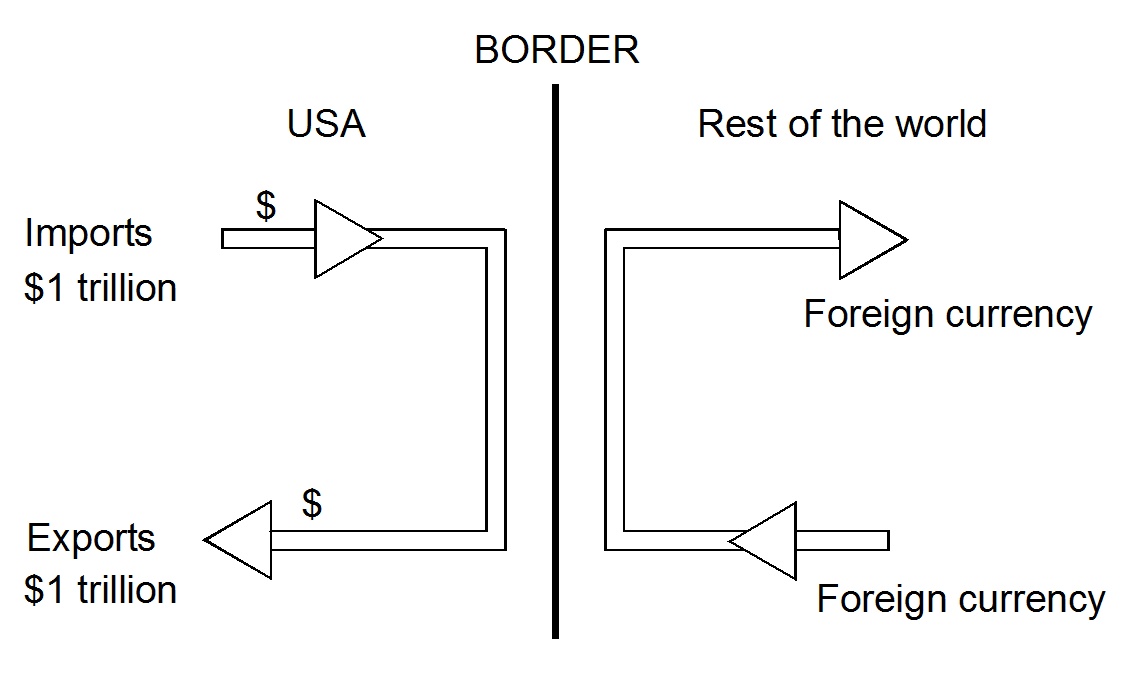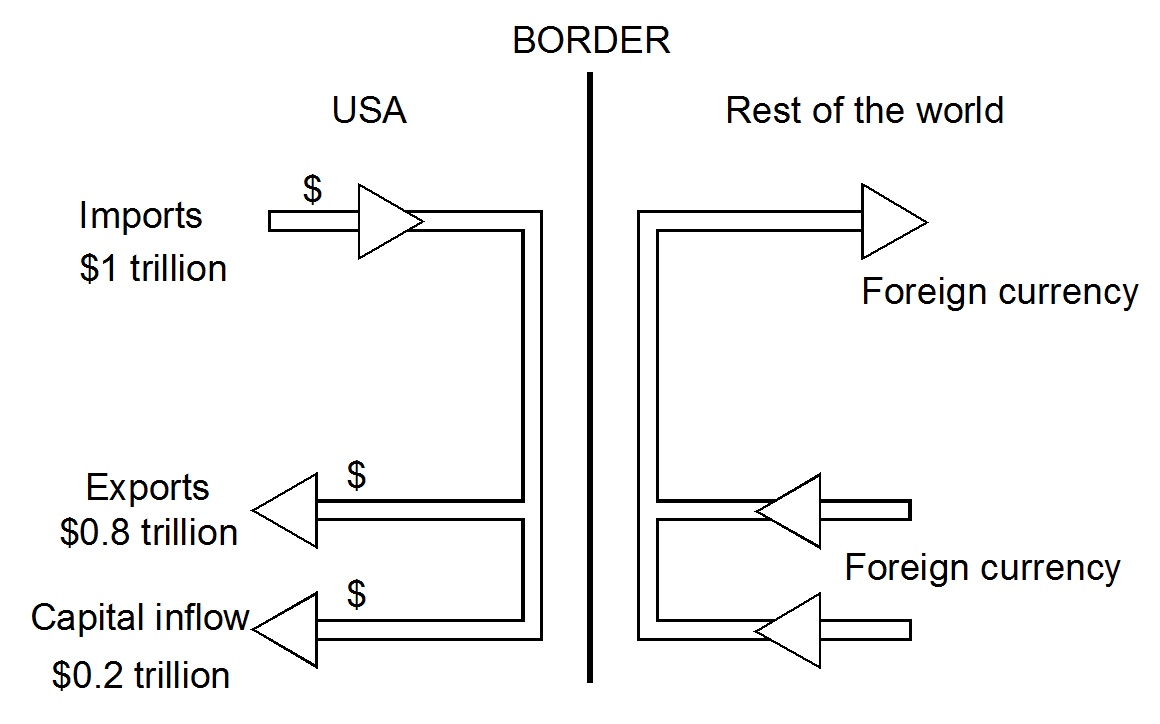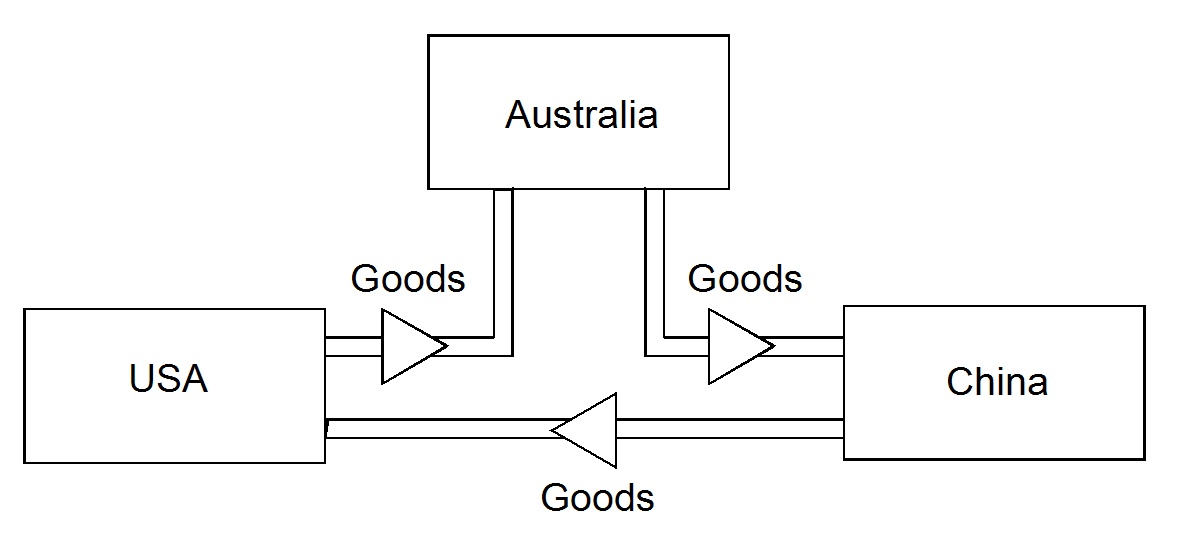Trade always balances
Imports and exports must necessarily be equal because US dollars do not leave the country. Importers convert their US dollars to a foreign currency to pay for goods, and exporters convert the foreign currency they receive for goods into US dollars. When importers and exporters exchange currencies through banks the amounts must be equal:

Capital inflow displaces some exports. This makes US imports more than the exports. The US has a trade deficit because of capital inflow. In essence, to get capital into the US, people bring goods into the US, sell it, and then that money becomes the capital:

(1) Half of this capital inflow is from foreign governments holding US$ as reserves. The reserves are supposed to be used to stabilize their own currency, by buying back their own currency when there is a big outflow. It is not clear whether this is ever used. The US$ and the € are attractive as reserve currency because (a) the perception of real interest rates relative to low inflation (might no longer be true) and (b) exploitation of comparative advantage through import protection and subsidies which strengthen the currencies.
(2) Capital inflow can also be foreigners investing in US stock markets. With the US having most of the big companies and brands, it will necessarily attract foreign investment. This could be reduced by these companies also listing in other countries.
(3) It could be money borrowed by the US government from other countries.
(3) It can also be foreigners who would rather hold US$ as protection against high inflation in their countries. Instead of blaming other countries for manipulating trade through tariffs, they should really be blamed for not offering their own citizens inflation beating investments.
Balance of payments
Apart from trade and capital flow, there is also cash transfers for salaries, etc. Imports + income payments + capital outflow must equal exports + income receipts + capital inflow, as reflected in the balance of payments. The chart below is the US trade balance (red) which was a deficit of $938B annualized in Nov 2024. When income payments and receipts are added you get a Current Account Balance of $1244B in Q3 of 2024 (blue), which should also be the net capital inflow, since they must add up to zero. The current account are all transactions which are not capital.

Trade between two countries
The trade between two countries is not necessarily balanced, for example China might need minerals from Australia, but Australia doesn't want to buy that much from China, so they buy some goods from the US, and US buys goods from China.

Import restriction
US import duties and subsidies make imports even cheaper, because it forces other countries to lower their prices in order to compete after the price is raised by import tariffs. It strengthens the dollar relative to other currencies, which makes US export more expensive. Also, if the US imports less, the dollar tends to strengthen until imports and exports reach a new balance. If China exports less, their currency would tend to weaken, until a new balance is reached.
The only solution to cheap imports is to import more so that the dollar weakens, which would make imports more expensive, and boosts exports.
The low paying jobs in businesses that struggle to make a profit, that are being saved by restricting imports, means losing jobs in exports due to the stronger dollar. These exports tend to be more advanced, new technology products where the pay is better.
The US has unique exports, which other countries want to buy, such as Hollywood movies, or passenger planes. Other countries have to pay for these US products by selling goods to the US. The US cannot stop all imports. The US needs to decide what products it will accept in return for its exports, and the obvious solution is for the US to concentrate on manufacturing the most profitable goods.
The best policy for governments is to allow free trade without any interference, because every business and every worker will naturally move towards the most profitable and highest paying jobs.
Import restrictions by other countries
When other countries restrict import through import duties or subsidies, they make their exports more expensive. This is only a problem if those exports are essential. In that case, foreigners are in effect offering more goods in exchange for those essential exports. If their exports are not essential, both import and exports decline, and the economy becomes less efficient by virtue of government subsidizing those activities.
End of page .
CONTACT INFORMATION
Corrections to: slandrp@gmail.com
This website is: www.slrp.co.za/US_trade_deficit
Disclaimer: No responsibility is accepted for wrong information, or for losses as a result of any information on this website. The contents should not be regarded as financial advice. Website visitors should consult with their own financial advisors before reacting to information.
Copyright @2018




